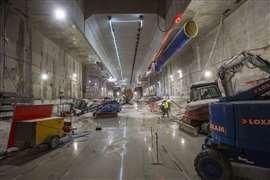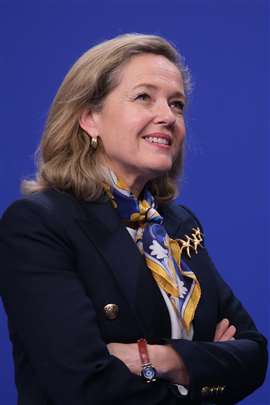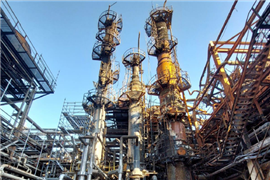How the European Investment Bank is under pressure to reshape infrastructure lending
11 March 2024
The EIB is coming under increasing pressure to change its criteria for lending to Europe’s biggest infrastructure projects. Lucy Barnard finds out what sort of projects will benefit - and who could lose out.
In a world where banks are facing increasing scrutiny over their lending, the European Investment Bank, the lending arm of the European Union (EU), must make some difficult choices.
The Luxembourg-based bank, which was founded in 1958 with a mandate to lend in the public interest, providing loans to projects and regions which might otherwise struggle to win backing from commercial financiers, is jointly owned by the EU’s 27 member states.
Over the last 66 years, the bank has mushroomed, growing to become the biggest public development bank in the world – even larger than the World Bank and providing loans touching all walks of life from the European Galileo satellite navigation system to the BioNTech covid vaccine development.
 Nathalie Climence, head of corporate financing for the European Investment Bank in France, Ireland and Benelux. Photo: EIB
Nathalie Climence, head of corporate financing for the European Investment Bank in France, Ireland and Benelux. Photo: EIB
In recent years, the bank has grown even more in political importance as cash-strapped EU countries have tapped into it to fund investments.
“The EIB supports projects that make a significant contribution to growth, employment, regional cohesion and environmental sustainability, in Europe and beyond,” says Nathalie Climence, head of corporate financing for the European Investment Bank in France, Ireland and Benelux. “EIB can support all sizes of companies that seek financing for investment projects aligned with EU policy priorities.”
One major area in which the bank is active is European infrastructure development, with previous projects including a £200 million loan towards the construction of the first section of the Channel Tunnel Rail link, a total of €1.8 billion in loans for the development of the Őresund Fixed Link between Denmark and Sweden, a €200 million loan towards the Fehmarn Belt Fixed Link, and €2 billion in loans towards the construction of the Grand Paris Express.
“[The EIB loans we have received] are particularly well suited to the requirements of the Société du Grand Paris,” said Philippe Yvin, chairman of the executive board of the Société du Grand Paris in 2017 when the second €1 billion tranche of EIB funding for the project was announced. “The overall financing model of the Grand Paris Express is based on long term loans, backed by tax revenue of around €550 million per year in support of a strategic investment for France.”
As a not-for-profit organization backed by 27 sovereign countries, the banks enjoys an AAA credit rating, allowing it to borrow money cheaply on the international markets and lend it at extremely low interest rates over long periods of time. The bank has a balance sheet total of €544 billion and a subscribed capital of €249 billion.
EIB infrastructure funding
Historically, one of the bank’s main function has been to channel the cheap money it raises as a result of this AAA rating into the sort of major infrastructure projects that advance the economies of its member states and bring Europeans closer together. The bank has been particularly supportive of the EU’s Trans European Transport Network, a web of rail, road and waterways designed to make it easier to travel and move goods between member states as well as historically funding airports, gas pipelines, power stations and dams.
Since the turn of the century the bank has also been coming under increasing pressure to finance projects in line with the EU’s efforts to tackle climate change. By 2025, the bank says it wants half of its lending activity to support ‘green’ projects, to help leverage €1 trillion of investment by 2030.
However, these twin aims do not always sit easily together. Over the past five years the bank has been coming under increasing pressure to meet its social and environmental mandate of ‘lending in the public good.’
In 2019, it announced it was phasing out lending to fossil fuel projects and in 2021 it tightened that to stop any lending to polluting companies that want to finance low carbon projects. At the same time the bank said it would no longer support airport expansion projects.
 Pont de Sèvres station - part of the vast Grand Paris Express network supported by EIB loans. Photo: SGP/David Delaporte
Pont de Sèvres station - part of the vast Grand Paris Express network supported by EIB loans. Photo: SGP/David Delaporte
“The EIB was the first multilateral bank to consider not just the climate impact of the projects it finances but also the wider activity of borrowers,” Climence says. “We ensure that projects financed by the EIB are not only aligned with the Paris Agreement but also that the party taking out the loan is taking steps towards decarbonizing business activity and strengthening resilience to climate change.”
Then in 2022, the bank went a step further, announcing more stringent tests for road infrastructure projects costing over €25 million which combines an estimated cost of carbon emissions and likely traffic congestion. Requests for funding for these projects must now be decided by the EIB’s management committee and board of directors made up of representatives from EU member states.
Instead, the EIB says it is increasing its funding for greener infrastructure projects, especially railway connections, city metros and renewable energy projects.
Recent recipients include the Brussels Capital Region in Belgium which received a €475 million loan in January to support the transformation of the city’s metro line 3 and a €250 million loan agreement in December with 2TDK to cofinance the construction of a second rail track in Slovenia.
Yet despite these moves, the bank is still attracting criticism from a growing number of non-governmental organisations which argue that the bank could be using European state cash better.
In January 2024, Spanish economist and politician Nadia Calviňo became president of the EIB, taking over from German banker Werner Hoyer after 12 years and becoming the first woman to lead the institution.
Campaigners call for change
Campaigners are urging Calviňo to ensure that the bank uses its financial clout to change the type of infrastructure projects the bank lends to.
Frank Vanaerschot, director of Counter Balance, an NGO which campaigns for greater transparency and accountability within European public banks says that last year, more than half the EIB’s loans (€39bn) went to financial institutions and corporations, eventually “lining the pockets of rich shareholders.”
“Calviňo takes the EIB helm at a critical moment for Europe,” he says. “She must seize the moment and make a just transition fundamental to the bank’s climate ambitions. Until now the EIB has provided significant support to big business, putting corporate profits over people,” he says. “To change this, the bank must use its €248bn of subscribed capital to finance environmentally friendly essential services like public housing and energy for the EU citizens and taxpayers who ultimately own the bank.”
Another criticism frequently levelled at the EIB is that it does not disclose enough information around many of its funding decisions when compared with other development agencies and public financial institutions.
According to Publish What You Fund, a UK-based campaigner for transparency among the world’s top donors, in 2022 the EIB was given a transparency score of 56.2% for its transparency efforts – lower than the World Bank, the World Health Organisation and the Gates Foundation.
 Nadia Calviňo became president of the EIB in January 2024. Photo: Oscar Gonzalez/ Reuters
Nadia Calviňo became president of the EIB in January 2024. Photo: Oscar Gonzalez/ Reuters
In 2022, the EU Ombudsman called on the EIB to adopt a “more ambitious approach to its disclosure practice” after three campaigning organisations, ClientEarth, CEE Bankwatch Network and Counter Balance complained that the bank had made it impossible to verify its claims to have dedicated €27.6bn to climate action and sustainability projects in 2021.
For her part, Climence points out that the EIB lends to a whole range of borrowers from giant corporations and state-run enterprises down to tiny startups and publishes lists of borrowers on its website.
In practical terms, however, EIB funding to SMEs is handled via a long list of financial intermediaries throughout the EU and beyond, and only mid-caps and larger firms looking to borrow €40m-€50m are dealt with directly by the bank.
“The EIB provides loans running from approximately four to twenty years, depending on the economic life of the assets to be financed,” says Climence. “Loan rates will also vary according to specific aspects such as currencies borrowed, amount, duration and timing of disbursement. The EIB’s contribution to a project’s cost is limited to 50% of the overall amount established during appraisal.”
“For a direct loan, a project appraisal must be carried out by the Bank’s teams of engineers, economists and financial analysts,” she adds. “Criteria are typically tailored to each specific project. The borrower needs to provide a detailed investment program for a specific period.”
Brought To You By
|
CONNECT WITH THE TEAM









